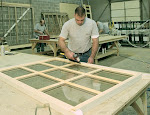I made the mistake of going Christmas shopping over the weekend and was forced to contend with the masses in the ritual of adorning the base of our tree with a bunch of stuff that nobody really needs. The experience made me think about the window industry. One outgrowth of our capitalistic society that I am disgusted with is the consumption-based mentality that has rapidly grown over the past fifty years. Manufacturers, advertisers, and the media have promulgated a lifestyle that is based upon fashion and instant gratification rather than substance. Just take a look at the hordes of people in the malls over the next couple of weeks if you don’t believe me. This boom of consumerism has given birth to a replacement society. When our cell phone breaks down, we replace it. When our television malfunctions, we swap it for a cheap replacement. Most of the clothing and furniture sold in the United States is cheap stuff manufactured in China that will need to be replaced before it goes out of style. And riding high on this trend for disposal is the window replacement industry.
Instead of pontificating about all the reasons one should restore historic windows rather than consider replacement, I'd like to address just one issue: replacement windows can ruin the look of a good building. Whether you are looking at vinyl, aluminum, wood, or steel replacement windows, there are very few manufacturers who offer acceptable facsimiles of the originals. These manufacturers contend with constraints that influence their engineering. Some are unable to replicate old windows because they use materials that cannot match the originals. Others are dedicated to sustaining a low price point and neglect to invest in suitable designs. And still others just don’t get it or don’t care to even pay attention. For the most part, the replacement window industry does a very poor job in offering products that look like the existing windows.
Even given vast improvements in UV inhibitors and advances in finishes, the vinyl window industry continues to produce primarily stark white products. Some manufacturers now offer a tan color. Talk about a segment that is mired in the Henry Ford era. They also contend with restrictions on size given the weak structural characteristics of the vinyl material and internal reinforcement. It is not uncommon to see two vinyl windows occupy an opening that once had a single double hung window simply because they cannot match the original window size. The vinyl window manufacturers are also under a great deal of pressure to maintain a competitive price point so most designs are very simplistic and ignore many of the profiles that add substance to the architecture.
The aluminum window manufacturers are very excited about the historic window arena given the state of the economy. They have become masters of attempting to make a standard window look custom. The formula they subscribe to is that you can make a standard window look like a replica by adding specially extruded trimmings to a basic window series. By applying a decorative brickmould and a surface-applied coped muntin bar to the window, it can now be promoted as “historic.” Most will even try to replicate the window lugs on the top sash by screwing a cast aluminum block to the lower corners of the upper sash. Unfortunately, the boxy appearance of the standard window design with stiles and rails that are much wider than the original completely alter the architecture. Many of these installations are set into an aluminum frame that is installed over the existing wood window frame, further infringing upon the sightlines of the original window.
The aluminum clad wood window manufacturers operate in a very similar fashion to their aluminum counterparts by taking standard products and adding trim such as brickmould and muntins that come close to matching existing designs. Stile and rail dimensions still fail to match. Their designs have size limitations on venting window units because of a an average sash thickness of only 1-3/8” and a cheap block and tackle balance system. This forces large units to become fixed or combined with other windows or infill. Most of the manufacturers have two options for replacement windows. One option is a package of two sash that are set in the original frame with a cheap plastic jamb liner that fails to match the existing finish. The other option is a window in a smaller frame that can be installed in the existing frame’s sash pocket just like a vinyl replacement window. The aluminum clad wood window manufacturers like to wrap the frame with aluminum break metal or profiled brickmould. This metal is often secured with exposed fasteners and caulking at all joints which attracts dust and fails within a couple of years. Often the break metal has a different finish than the window and fades at a different rate. Another disadvantage is a design that inhibits the ability to repair the window. If the glass breaks, the entire sash and often the entire unit must be replaced. So these manufacturers have successfully designed a bona fide “replacement window”.
So if you find yourself getting caught up in the spirit of consumerism this season and begin to have dreams of sugar plums and iPhones, remember that your work is your signature. You really don't want to have your name associated with some of the common replacement window problems pictured below:
These stark white vinyl window replacements
had to be fixed windows since the window
opening is too big for a vinyl double hung.
And they even added decorative trim
to the infill for this aluminum window
replacement. If you are going to ruin a
building, you might as well do it with style.
Note how these aluminum replacements
attempt to simulate a double hung
window with a fake horizontal rail. I guess
if you are going to put an awning like
that over the entrance, it doesn't matter
what the windows look like.
Take a look at the aluminum window replacements on the
third floor compared to the original wood windows on
the second floor. If this picture doesn't convince you of
how aluminum window replacements will change sightlines
than nothing will.
The reduced sightlines of an aluminum
replacement window don't look any
better from the interior.
This is a common situation where the
aluminum window manufacturer cannot
make a venting window of this size so
they settle on a fixed/hopper combo.
Look at the infill panels on these
aluminum replacement windows.
This aluminum clad wood window replacement shows how
the sightlines have been completely changed. The aluminum
break metal has none of the profiles of the original millwork.
Also note how the window has faded at a different rate than
the break metal.
Note the exposed fasteners and dirty sealant
lines on this aluminum clad replacement window.
Observe the stark contrast in metal colors due
to using different finishes on the window and the frame.
Note the fake sash lug on the corner
of the upper sash. Why even try to
match the original when it looks this bad?
















vinyl replacement windows are right for my home because they are affordable, easy to maintain, greatly cut down on the cost of energy, and are easy to customize.
ReplyDelete